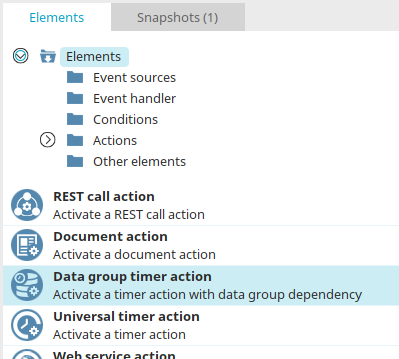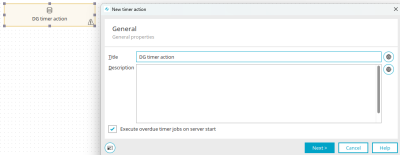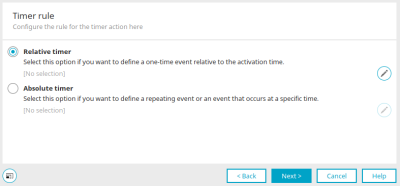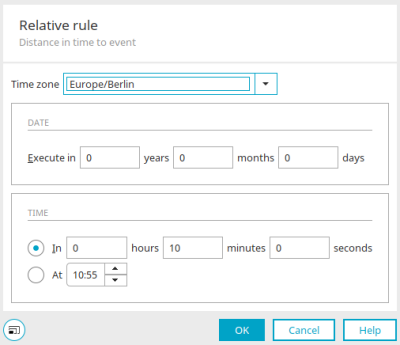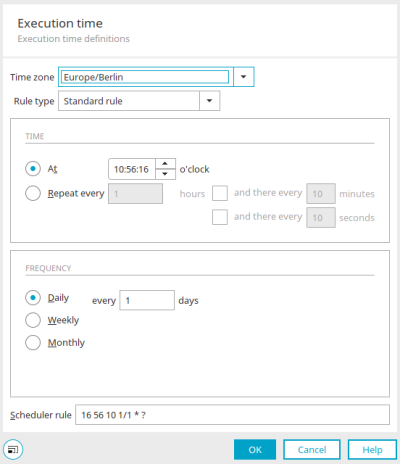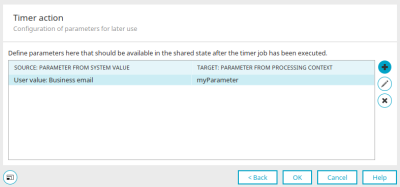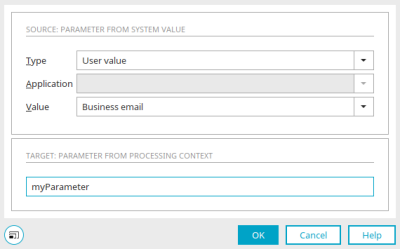Timer action
With a data group timer action, you define a time-controlled event that is triggered during the process, just like with a global timer. As opposed to the global timer, a task will be generated once the timer action is initiated in the process chain.
The data group timer action must be linked to a data group or timer event handler that reacts to another data group timer action or a global timer with a data group reference. This is the only way to configure the action.
When it is triggered, it generates a task for every received data record. In the "Tools" module, the data record GUID is included for each of these tasks. This GUID can be used in groovy or generic event handlers.
Here is an example: A data group event handler reacts to the change of reports. The timer should report each unreleased report via email. If you want to react to a data group timer action in the further course of the process, you need an event handler (timer, groovy or generic event handler) that reacts to the task generated by the data group timer action at the defined time.
Create data group timer action
The data group timer action can be found in processes in the "Elements" area. It belongs to the "Actions" category. From there, it can be dragged and dropped to the desired position in the process chain and then configured. General information on creating process elements can be found here.
If you have created the data group timer action on the workspace, open the properties dialog by double-clicking on the element.
General
Information on the settings in this dialog can be found here.
Click "Next".
Timer rule
The rule for the timer action can be defined here. You can choose between a relative and an absolute timer - e.g. for notifications indicating that a contract is about to end.
The relative timer can be used to define a one-time event relative to the trigger time.
The absolute timer can be used to define a recurring event or an event that occurs at a specific time. A reminder for a report that has not been released would then be sent daily at 7:00 AM.
![]() Edit rule
Edit rule
Opens the corresponding configuration dialog.
Relative timer - Relative rule
The relative rule defines the temporal distance to the event. Set the time zone here. In the "Date" area, you can specify the number of years, months and days in which the timer action should be executed. In the "Time" area, the time interval to the triggering event can be specified in hours, minutes and seconds if you select the "In" option. The "At" option can be used to enter a fixed time at which the timer action is executed.
Absolute timer - execution time
All information on the settings for an absolute timer can be found here.
Once you have set the timer rule, click "OK" to save the changes and close the dialog again.
Click "Next".
Parameters
Parameters can be defined here that are available in the processing context after the timer action has been executed. Parameters that have already been defined are displayed as a list. ![]() "Delete parameter" deletes an existing parameter.
"Delete parameter" deletes an existing parameter.
![]() Add parameters /
Add parameters / ![]() Edit parameters
Edit parameters
Opens a dialog in which a parameter with a value can be defined or edited.
Edit parameter
Source: Parameter from system value
Type
You can choose from the following system values:
-
Request values
-
Session values
-
Processing context
-
System data groups
-
User values
The prerequisite is that it is a serializable value, e.g. string, number, date values etc. ValueHolder cannot be used, please use the Value property instead.
Application
For a value from a system data group, select the application that contains the system data group.
Value
Enter the value of the parameter here. A data field from the "User" module can be selected for the user value type. The data field can be selected for system data groups.
Target: Parameters from processing context
When the timer action is executed, the parameters are made available under the name specified here.
Example
For example, you can use the session value type to define your own session variable with any target variable name (e.g. "mySessionValue") and then evaluate it in a Groovy condition as follows:
if (g_sharedState.mySessionValue == "red")
stop()
else
go()
Click "OK" to save the parameter definition and close the dialog again.
Click "OK" here to complete the configuration of the timer action.
More information
Create and manage processes
